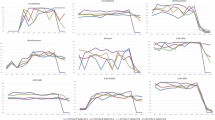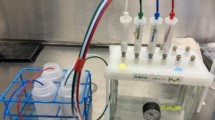Abstract
Iodoacetic acid (IAA) is a halogenated disinfection by-product of growing concern due to its high cytotoxicity, genotoxicity, endocrine disruptor effects, and potential carcinogenicity. However, the data on distribution and excretion of IAA after ingestion by mammals are still scarce. Here, we developed a reliable and validated method for detecting IAA in biological specimens (plasma, urine, feces, liver, kidney, and tissues) based on modified QuEChERS sample preparation combined with gas chromatography-tandem triple quadrupole mass spectrometry (GC–MS/MS). The detection method for IAA exhibited satisfactory recovery rates (62.6–108.0%) with low relative standard deviations (RSD < 12.3%) and a low detection limit for all biological matrices ranging from 0.007 to 0.032 ng/g. The study showed that the proposed method was reliable and reproducible for analyzing IAA in biological specimens. It was successfully used to detect IAA levels in biological samples from rats given gavage administration. The results indicated that IAA was found in various tissues and organs, including plasma, thyroid, the liver, the kidney, the spleen, gastrointestinal tract, and others, 6 h after exposure. This study provides the first data on the in vivo distribution in and excretion of IAA by mammals following oral exposure.
Graphical abstract



Similar content being viewed by others
References
MacKeown H, von Gunten U, Criquet J. Iodide sources in the aquatic environment and its fate during oxidative water treatment - a critical review. Water Res. 2022;217: 118417. https://doi.org/10.1016/j.watres.2022.118417.
Dong H, Qiang Z, Richardson SD. Formation of iodinated disinfection byproducts (I-DBPs) in drinking water: emerging concerns and current issues. Acc Chem Res. 2019;52(4):896–905. https://doi.org/10.1021/acs.accounts.8b00641.
Harkness JS, Dwyer GS, Warner NR, Parker KM, Mitch WA, Vengosh A. Iodide, bromide, and ammonium in hydraulic fracturing and oil and gas wastewaters: environmental implications. Environ Sci Technol. 2015;49(3):1955–63. https://doi.org/10.1021/es504654n.
Li J, Jiang J, Pang SY, Yang Y, Sun S, Wang L, et al. Transformation of X-ray contrast media by conventional and advanced oxidation processes during water treatment: efficiency, oxidation intermediates, and formation of iodinated byproducts. Water Res. 2020;185: 116234. https://doi.org/10.1016/j.watres.2020.116234.
Richardson SD, Fasano F, Ellington JJ, Crumley FG, Buettner KM, Evans JJ, et al. Occurrence and mammalian cell toxicity of iodinated disinfection byproducts in drinking water. Environ Sci Technol. 2008;42(22):8330–8. https://doi.org/10.1021/es801169k.
Wei X, Wang S, Zheng W, Wang X, Liu X, Jiang S, et al. Drinking water disinfection byproduct iodoacetic acid induces tumorigenic transformation of NIH3T3 cells. Environ Sci Technol. 2013;47(11):5913–20. https://doi.org/10.1021/es304786b.
Wagner ED, Plewa MJ. CHO cell cytotoxicity and genotoxicity analyses of disinfection by-products: an updated review. J Environ Sci (China). 2017;58:64–76. https://doi.org/10.1016/j.jes.2017.04.021.
Xia Y, Mo Y, Yang Q, Yu Y, Jiang M, Wei S, et al. Iodoacetic acid disrupting the thyroid endocrine system in vitro and in vivo. Environ Sci Technol. 2018;52(13):7545–52. https://doi.org/10.1021/acs.est.8b01802.
Long K, Sha Y, Mo Y, Wei S, Wu H, Lu D, et al. Androgenic and teratogenic effects of iodoacetic acid drinking water disinfection byproduct in vitro and in vivo. Environ Sci Technol. 2021;55(6):3827–35. https://doi.org/10.1021/acs.est.0c06620.
Shi XM. Revision and prospect of the “standards for drinking water quality (GB5749-2022)” in China. Zhonghua Yu Fang Yi Xue Za Zhi. 2023;57(6):801–5. https://doi.org/10.3760/cma.j.cn112150-20221027-01039.
Pérez-Albaladejo E, Pinteño R, Aznar-Luque MDC, Casado M, Postigo C, Porte C. Genotoxicity and endocrine disruption potential of haloacetic acids in human placental and lung cells. Sci Total Environ. 2023;879: 162981. https://doi.org/10.1016/j.scitotenv.2023.162981.
Directive (EU) 2020/2184 of the European Parliament and of the Council of 16 December 2020 on the quality of water intended for human consumption (recast). https://eur-lex.europa.eu/legal-content/EN/TXT/PDF/?uri=CELEX:32020L2184&qid=1697799846322. Accessed 20 Oct 2023.
Lau BP, Becalski A. Determination of iodoacetic acid using liquid chromatography/electrospray tandem mass spectrometry. Rapid Commun Mass Spectrom. 2008;22(12):1787–91. https://doi.org/10.1002/rcm.3547.
Shi H, Adams C. Rapid IC-ICP/MS method for simultaneous analysis of iodoacetic acids, bromoacetic acids, bromate, and other related halogenated compounds in water. Talanta. 2009;79(2):523–7. https://doi.org/10.1016/j.talanta.2009.04.037.
Zhang H, Zhu J, Aranda-Rodriguez R, Feng YL. Pressure-assisted electrokinetic injection for on-line enrichment in capillary electrophoresis-mass spectrometry: a sensitive method for measurement of ten haloacetic acids in drinking water. Anal Chim Acta. 2011;706(1):176–83. https://doi.org/10.1016/j.aca.2011.07.040.
Domino MM, Pepich BV, Munch DJ, Fair PS, Xie Y. Method 552.3 Determination of haloacetic acids and dalapon in drinking water by liquid-liquid microextraction, derivatization, and gas chromatography with electron capture detection. US EPA. 2003. https://nepis.epa.gov/Exe/ZyNET.exe/901V0400.TXT?ZyActionD=ZyDocument&Client=EPA&Index=2000+Thru+2005&Docs=&Query=&Time=&EndTime=&SearchMethod=1&TocRestrict=n&Toc=&TocEntry=&QField=&QFieldYear=&QFieldMonth=&QFieldDay=&IntQFieldOp=0&ExtQFieldOp=0&XmlQuery=&File=D%3A%5Czyfiles%5CIndex%20Data%5C00thru05%5CTxt%5C00000011%5C901V0400.txt&User=ANONYMOUS&Password=anonymous&SortMethod=h%7C-&MaximumDocuments=1&FuzzyDegree=0&ImageQuality=r75g8/r75g8/x150y150g16/i425&Display=hpfr&DefSeekPage=x&SearchBack=ZyActionL&Back=ZyActionS&BackDesc=Results%20page&MaximumPages=1&ZyEntry=1&SeekPage=x&ZyPURL. Accessed 20 Oct 2023.
Cuthbertson AA, Liberatore HK, Kimura SY, Allen JM, Bensussan AV, Richardson SD. Trace Analysis of 61 Emerging Br-, Cl-, and I-DBPs: new methods to achieve part-per-trillion quantification in drinking water. Anal Chem. 2020;92(4):3058–68. https://doi.org/10.1021/acs.analchem.9b04377.
Allen JM, Plewa MJ, Wagner ED, Wei X, Bokenkamp K, Hur K, et al. Drivers of disinfection byproduct cytotoxicity in U.S. drinking water: should other DBPs be considered for regulation? Environ Sci Technol. 2022;56(1):392–402. https://doi.org/10.1021/acs.est.1c07998.
Liu X, Wei X, Zheng W, Jiang S, Templeton MR, He G, et al. An optimized analytical method for the simultaneous detection of iodoform, iodoacetic acid, and other trihalomethanes and haloacetic acids in drinking water. PLoS ONE. 2013;8(4): e60858. https://doi.org/10.1371/journal.pone.0060858.
Cardador MJ, Gallego M. Eco-friendly microextraction method for the quantitative speciation of 13 haloacetic acids in water. J Chromatogr A. 2014;1340:15–23. https://doi.org/10.1016/j.chroma.2014.03.019.
Diallo T, Leleu J, Parinet J, Guérin T, Thomas H, Lerebours A. Approaches to determine pesticides in marine bivalves. Anal Bioanal Chem. 2023;415(16):3093–110. https://doi.org/10.1007/s00216-023-04709-4.
Anastassiades M, Lehotay SJ, Stajnbaher D, Schenck FJ. Fast and easy multiresidue method employing acetonitrile extraction/partitioning and “dispersive solid-phase extraction” for the determination of pesticide residues in produce. J AOAC Int. 2003;86(2):412–31.
Cox J, Train A, Field A, Ott C, DelTondo J, Kraner J, et al. Quantitation of fentanyl and metabolites from liver tissue using a validated QuEChERS extraction and LC-MS-MS analysis. J Anal Toxicol. 2021;44(9):957–67. https://doi.org/10.1093/jat/bkaa006.
Manz KE, Yamada K, Scheidl L, La Merrill MA, Lind L, Pennell KD. Targeted and nontargeted detection and characterization of trace organic chemicals in human serum and plasma using QuEChERS extraction. Toxicol Sci. 2021;185(1):77–88. https://doi.org/10.1093/toxsci/kfab121.
Wang Y, Sun Y, Chen T, Shi Z, Zhou X, Sun Z, et al. Determination of polybrominated diphenyl ethers and novel brominated flame retardants in human serum by gas chromatography-atmospheric pressure chemical ionization-tandem mass spectrometry. J Chromatogr B Analyt Technol Biomed Life Sci. 2018;1099:64–72. https://doi.org/10.1016/j.jchromb.2018.09.015.
Mendes MI, Cunha SC, Rebai I, Fernandes JO. Algerian workers’ exposure to mycotoxins-a biomonitoring study. Int J Environ Res Public Health. 2023;20(16):6566. https://doi.org/10.3390/ijerph20166566.
Stubbings G, Bigwood T. The development and validation of a multiclass liquid chromatography tandem mass spectrometry (LC-MS/MS) procedure for the determination of veterinary drug residues in animal tissue using a QuEChERS (QUick, Easy, CHeap, Effective, Rugged and Safe) approach. Anal Chim Acta. 2009;637(1–2):68–78. https://doi.org/10.1016/j.aca.2009.01.029.
DeArmond PD, Brittain MK, Platoff GE Jr, Yeung DT. QuEChERS-based approach toward the analysis of two insecticides, methomyl and aldicarb, in blood and brain tissue. Anal Methods. 2015;7(1):321–8. https://doi.org/10.1039/C4AY02137A.
Hamamoto K, Iwatsuki K, Akama R, Koike R. Rapid multiresidue determination of pesticides in livestock muscle and liver tissue via modified QuEChERS sample preparation and LC-MS/MS. Food Addit Contam Part A Chem Anal Control Expo Risk Assess. 2017;34(7):1162–71. https://doi.org/10.1080/19440049.2017.1319075.
Zhu Y, Pan X, Jia Y, Yang X, Song X, Ding J, et al. Exploring Route-specific pharmacokinetics of PFAS in mice by coupling in vivo tests and physiologically based toxicokinetic models. Environ Health Perspect. 2023;131(12): 127012. https://doi.org/10.1289/EHP11969.
Directive 2010/63/EU of the European Parliament and of the Council of 22 September 2010 on the protection of animals used for scientific purposes. Official Journal of the European Union. 2010. https://eur-lex.europa.eu/legal-content/EN/TXT/PDF/?uri=CELEX:32010L0063&qid=1698056364162. Accessed 20 Oct 2023.
M10 bioanalytical method validation and study sample analysis guidance for industry. US FDA. 2018. https://www.fda.gov/regulatory-information/search-fda-guidance-documents/bioanalytical-method-validation-guidance-industry. Accessed 20 Oct 2023.
Xiang L, Chen L, Xiao T, Mo CH, Li YW, Cai QY, et al. Determination of trace perfluoroalkyl carboxylic acids in edible crop matrices: matrix effect and method development. J Agric Food Chem. 2017;65(39):8763–72. https://doi.org/10.1021/acs.jafc.7b02677.
Yao Y, Shao Y, Zhan M, Zou X, Qu W, Zhou Y. Rapid and sensitive determination of nine bisphenol analogues, three amphenicol antibiotics, and six phthalate metabolites in human urine samples using UHPLC-MS/MS. Anal Bioanal Chem. 2018;410(16):3871–83. https://doi.org/10.1007/s00216-018-1062-2.
OECD Guidelines for the Testing of Chemicals, Section 4: health effects test no. 417: Toxicokinetics. OECD/OCDE. 2010. https://read.oecd-ilibrary.org/environment/test-no-417-toxicokinetics_9789264070882-en#page1. Accessed 25 Jan 2024.
Xiong Q, Wu D, Cheng YX, Hu LX, Chen QL, Wu HY, et al. Development and validation of a simultaneous method for the analysis of benzothiazoles and organic ultraviolet filters in various environmental matrices by GC-MS/MS. Anal Bioanal Chem. 2022;414(22):6541–55. https://doi.org/10.1007/s00216-022-04212-2.
Cardador MJ, Gallego M. Development of a method for the quantitation of chloro-, bromo-, and iodoacetic acids in alcoholic beverages. J Agric Food Chem. 2012;60(3):725–30. https://doi.org/10.1021/jf2040077.
Xie YF, Rashid I, Zhou HJ, Gammie L. Acidic methanol methylation for HAA analysis: limitations and possible solutions. J Am Water Works Assoc. 2002;94(11):115–22.
Acknowledgements
The first author would like to thank Xi Lin from Jiading CDC for the help during the experimental part of this study.
Funding
This research was supported by the National Key Research and Development Program of China [2023YFF1104800, 2017YFC1600500], the National Standard for Drinking Water Quality from National Institutes of Environmental Health, China CDC [2021], the National Natural Science Foundation of China [81373089, 82241089], Food Safety Risk Assessment Project of Shanghai in China (RA-2023–17), and Scientific Research Foundation of Shanghai Pudong New Area Commission of Health and Family Planning (PW2017A-13).
Author information
Authors and Affiliations
Contributions
Ying Zhou and Hanning Yu conceived and designed the research. Hanning Yu conducted the experiments, analyzed the data, and wrote the manuscript. Linying Wu, Dongliang Xuan, and Qian Peng provided experimental equipment and technical support. Weidong Qu and Ying Zhou revised the manuscript. Ying Zhou supervised this study. All authors listed have made substantial contributions to the work and approved it for publication.
Corresponding authors
Ethics declarations
Ethical approval
The animal use was approved by the Animal Ethics Committee of Fudan University. All procedures were conducted following to the National Ethics Committee for Care and Use of Laboratory Animals for Research. Every effort was made to minimize animal suffering and to reduce the number of animals used, in accordance with the principles of the 3Rs (Replacement, Reduction, and Refinement).
Conflict of interest
The authors declare no competing interests.
Additional information
Publisher's note
Springer Nature remains neutral with regard to jurisdictional claims in published maps and institutional affiliations.
Supplementary information
Below is the link to the electronic supplementary material.
Rights and permissions
Springer Nature or its licensor (e.g. a society or other partner) holds exclusive rights to this article under a publishing agreement with the author(s) or other rightsholder(s); author self-archiving of the accepted manuscript version of this article is solely governed by the terms of such publishing agreement and applicable law.
About this article
Cite this article
Yu, H., Wu, L., Xuan, D. et al. Development and validation of a GC–MS/MS method for the determination of iodoacetic acid in biological samples. Anal Bioanal Chem (2024). https://doi.org/10.1007/s00216-024-05266-0
Received:
Revised:
Accepted:
Published:
DOI: https://doi.org/10.1007/s00216-024-05266-0




